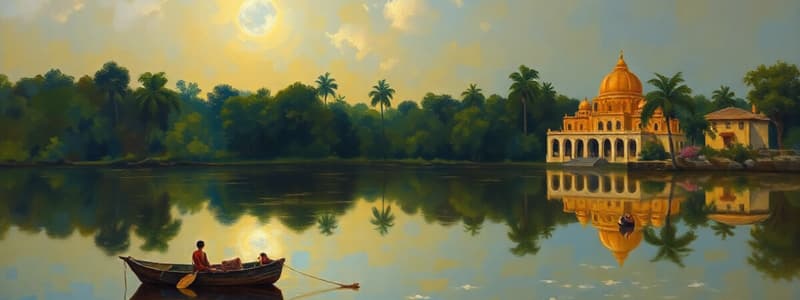Podcast
Questions and Answers
The Satpura Range, a significant feature of Central India's ______, is known for its dense forests and mineral resources.
The Satpura Range, a significant feature of Central India's ______, is known for its dense forests and mineral resources.
physiography
Rapid ______ in cities like Indore and Bhopal is transforming Central India's socio-economic dynamics.
Rapid ______ in cities like Indore and Bhopal is transforming Central India's socio-economic dynamics.
urbanization
The Gond ______, one of the largest in Central India, have a rich cultural heritage closely linked to the region's forests.
The Gond ______, one of the largest in Central India, have a rich cultural heritage closely linked to the region's forests.
tribes
The Western Ghats significantly influence South India's ______, causing substantial orographic rainfall.
The Western Ghats significantly influence South India's ______, causing substantial orographic rainfall.
The growth of IT hubs in cities like Bangalore and Chennai underscores the rapid ______ of South India.
The growth of IT hubs in cities like Bangalore and Chennai underscores the rapid ______ of South India.
The Toda ______ of the Nilgiri Hills in South India are known for their unique pastoral traditions and distinctive houses.
The Toda ______ of the Nilgiri Hills in South India are known for their unique pastoral traditions and distinctive houses.
The Thar Desert defines much of Western India's ______, contributing to its arid climate and unique ecosystems.
The Thar Desert defines much of Western India's ______, contributing to its arid climate and unique ecosystems.
The expansion of Mumbai and Pune highlights the increasing ______ and economic development in Western India.
The expansion of Mumbai and Pune highlights the increasing ______ and economic development in Western India.
The Bhil ______, found across parts of Western India, have a distinct cultural identity and traditions.
The Bhil ______, found across parts of Western India, have a distinct cultural identity and traditions.
The Himalayan mountain range dominates the ______ of North India, influencing its climate and river systems.
The Himalayan mountain range dominates the ______ of North India, influencing its climate and river systems.
Increased migration to cities like Delhi and Chandigarh indicates the pace of ______ in North India.
Increased migration to cities like Delhi and Chandigarh indicates the pace of ______ in North India.
The Gujjar ______ in North India are known for their pastoral lifestyle tied to the Himalayan foothills.
The Gujjar ______ in North India are known for their pastoral lifestyle tied to the Himalayan foothills.
Flashcards
Urbanization
Urbanization
The movement of people from rural areas to cities, leading to city growth.
Tribes
Tribes
Communities with distinct cultures, often living in specific geographic regions, and maintaining unique traditions.
Physiography
Physiography
The physical features of a region, including mountains, plains, and rivers.
Urbanization in Central India
Urbanization in Central India
Signup and view all the flashcards
Tribes of Central India
Tribes of Central India
Signup and view all the flashcards
Study Notes
Central India
- Urbanization: Central India has seen increasing urbanization due to economic opportunities, leading to growth in cities like Indore and Bhopal.
- Tribes: The region is home to significant tribal populations, such as the Gond and Bhil, who maintain distinct cultural traditions and have unique relationships with the environment.
- Physiography: Central India's landscape includes the Vindhya and Satpura ranges, which influence the region's climate, vegetation, and land use patterns.
South India
- Urbanization: South India is highly urbanized with major tech hubs like Bangalore, Chennai, and Hyderabad driving economic growth and attracting migrants.
- Tribes: The region is home to various indigenous tribes, each with its own distinct culture and traditions, such as the Toda in the Nilgiri Hills.
- Physiography: South India features the Deccan Plateau, Western and Eastern Ghats, and fertile coastal plains, significantly impacting agriculture and biodiversity.
Western India
- Urbanization: Western India includes the metropolitan areas of Mumbai and Ahmedabad, experiencing rapid urbanization that leads to infrastructure and social challenges.
- Tribes: The region is home to various tribal communities, such as the Bhils in the western part of the Vindhya range, each with unique social structures and cultural practices.
- Physiography: Western India features the Thar Desert, the Rann of Kutch, and the Western Ghats, influencing climate patterns, land use, and biological diversity.
North India
- Urbanization: North India is experiencing rapid urbanization, with cities like Delhi and Kanpur struggling to manage population growth and infrastructure demands.
- Tribes: The region includes tribal communities like the Gujjars in the Himalayan foothills, who maintain traditional pastoral lifestyles and cultural identities.
- Physiography: North India is defined by the Himalayas, the Indo-Gangetic Plain, and the Thar Desert, which collectively determine the region's climate, agriculture, and water resources.
Studying That Suits You
Use AI to generate personalized quizzes and flashcards to suit your learning preferences.




